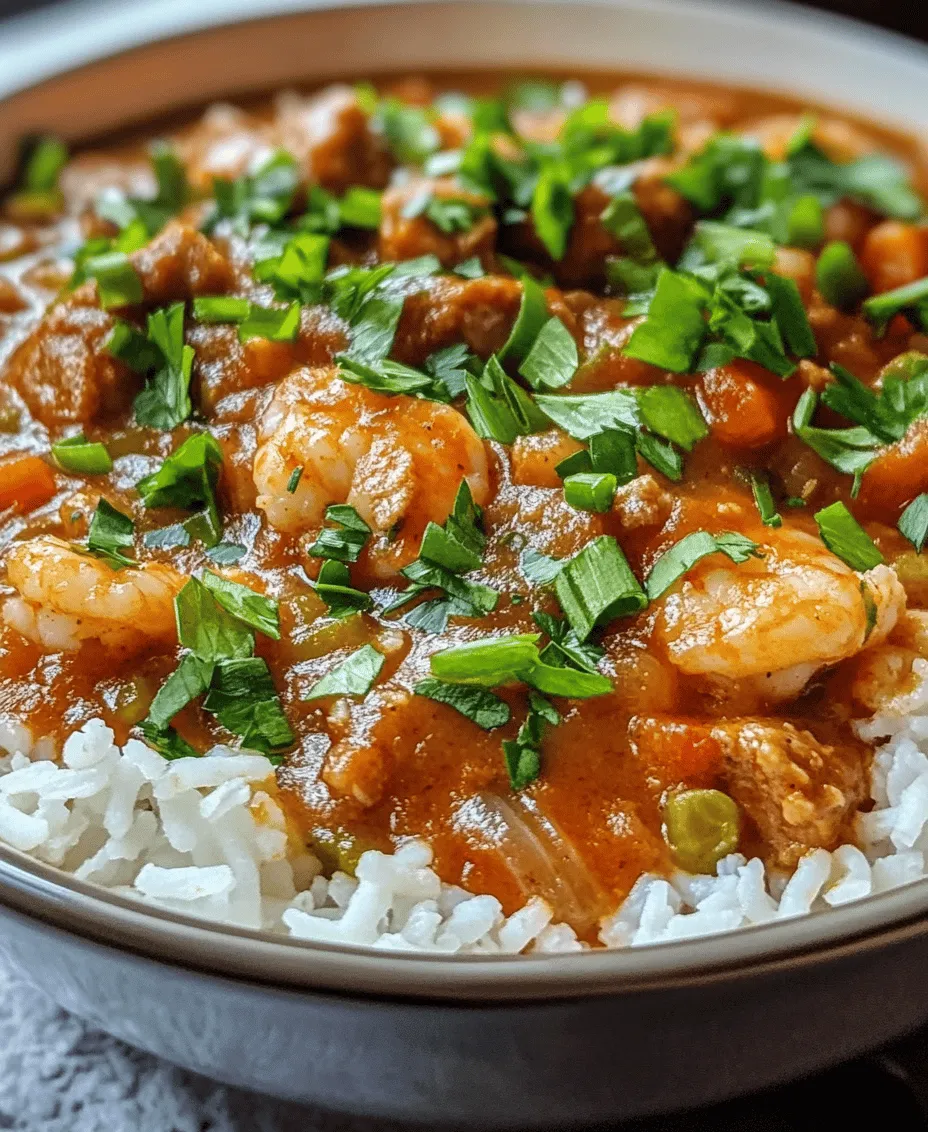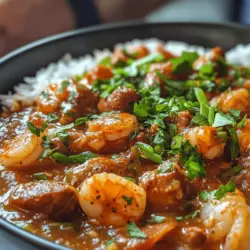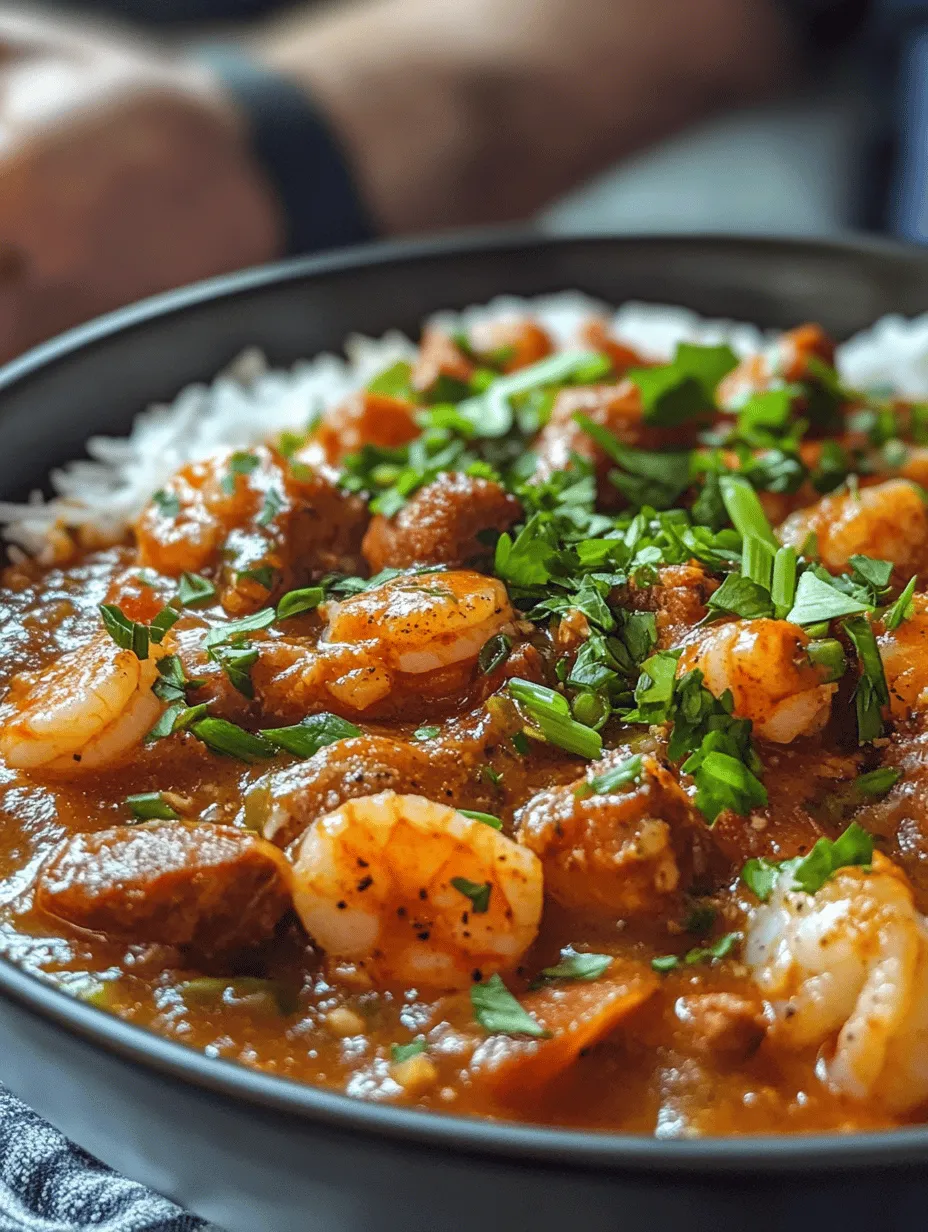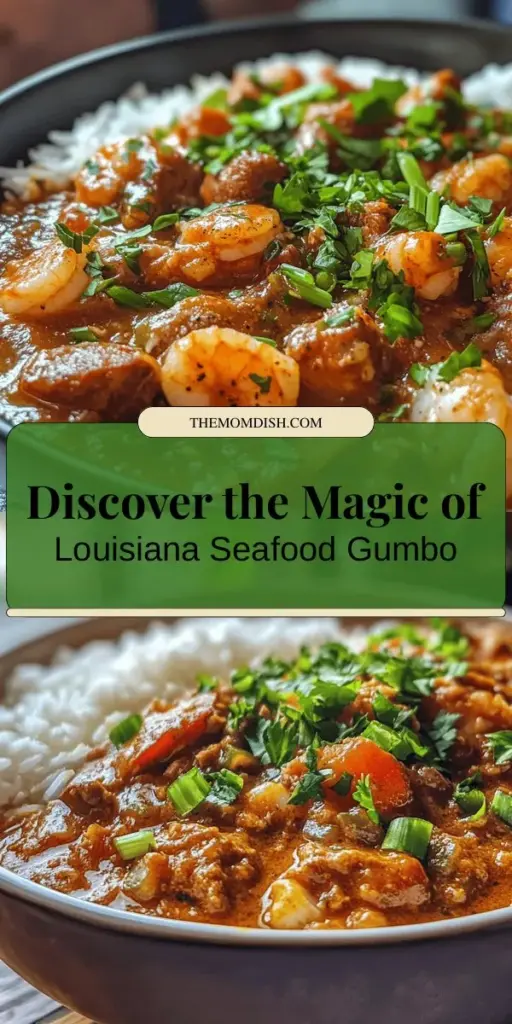Louisiana Seafood Gumbo is a culinary treasure that embodies the rich, vibrant flavors of Southern cuisine. This hearty dish combines a variety of fresh seafood, savory andouille sausage, and a robust mix of spices, all simmered to perfection in a thick, flavorful broth. Gumbo is not just a meal; it’s a celebration of culture, history, and community, often served at gatherings and special occasions. In this article, we will explore the origins of gumbo, its essential ingredients, a step-by-step guide to preparing this delectable dish, and how to serve it for an authentic Louisiana experience.
The Origins of Gumbo
Understanding the cultural significance of gumbo begins with its history, which is as rich and complex as the dish itself. Gumbo is a true reflection of Louisiana’s diverse cultural tapestry, weaving together the influences of various groups that settled in the region. The dish is often regarded as a melting pot of flavors, influenced primarily by French, African, and Spanish culinary traditions.
The French brought the concept of a stew to the bayou, while West African slaves contributed the thickening agent of okra, which is often included in gumbo. The Spanish introduced spices and cooking techniques that further enriched the dish. As a result, gumbo is not just a meal; it tells the story of a place where cultures intersect, and flavors meld harmoniously.
Regional variations of gumbo are abundant across Louisiana, with each area offering its own twist on this classic dish. In New Orleans, for instance, seafood gumbo is a staple, showcasing the abundant catch from the Gulf of Mexico. Conversely, in Acadiana, or Cajun Country, you might find a spicier, sausage-based gumbo featuring ingredients like duck or rabbit. Regardless of the variation, gumbo remains a beloved dish that brings people together, whether it is served at a family gathering, a festive celebration, or simply enjoyed on a cozy night at home.
Essential Ingredients for Louisiana Seafood Gumbo
The key components that make gumbo unique are both simple and essential, creating a symphony of flavors in each bowl. The first element to highlight is the “holy trinity” of Cajun cooking: onions, bell peppers, and celery. This aromatic combination forms the foundation of many Louisiana dishes, providing a depth of flavor that enhances the overall dish.
Another critical ingredient is seafood stock, which serves as the base of the gumbo. The stock not only adds flavor but also infuses the dish with a richness that elevates the seafood components. While you can purchase pre-made seafood stock, making your own from shrimp shells and fish bones will yield an even more robust flavor profile.
Andouille sausage plays a pivotal role in Southern cuisine, contributing a smoky, spicy element that balances the sweetness of the seafood. This sausage is typically made from pork and seasoned with a blend of spices, making it an ideal complement to the dish.
When it comes to seafood, fresh is always preferable, but frozen seafood can be a convenient alternative without compromising quality. Common seafood choices for gumbo include shrimp, crab, and oysters, each of which adds its own distinct flavor and texture to the dish. Consider using a mix of fresh seafood to create a more complex and satisfying gumbo experience.
Preparation: Creating the Perfect Roux
The significance of roux in gumbo cannot be overstated. This thickening agent, made from equal parts flour and fat, serves as the heart of the dish, providing both flavor and texture. The process of making a roux requires patience and attention, as the key to a great gumbo lies in achieving the perfect balance of color and flavor.
To make a rich, dark roux, start by heating equal parts oil (or butter) and flour in a heavy-bottomed pot over medium heat. Stir the mixture continuously to prevent burning, as it can go from light brown to burnt in a matter of seconds. The goal is to achieve a dark chocolate brown color, which can take anywhere from 20 to 40 minutes, depending on the heat level. This dark roux will impart a deep, nutty flavor to your gumbo, setting the stage for the rest of the ingredients.
Common mistakes to avoid when cooking roux include cooking on too high of heat, which can lead to burning, and not stirring continuously. Remember, patience is key, and the effort you put into your roux will pay off in the depth of flavor it brings to your gumbo.
Cooking the Vegetables
Once the roux is perfected, it’s time to incorporate the holy trinity into the gumbo. Start by adding diced onions, bell peppers, and celery to the roux, stirring well to combine. This step is crucial, as sautéing the vegetables in the roux allows them to absorb the flavors while softening and caramelizing, enhancing their natural sweetness.
Tips for sautéing vegetables to enhance their flavors include cooking them over medium heat to allow for even cooking without burning. Additionally, you can season the vegetables with a pinch of salt early in the cooking process to help draw out their moisture, allowing them to cook down more effectively. This step helps to create a flavorful base for your gumbo, setting the stage for the addition of the seafood and broth.
As you continue to develop the flavors in your gumbo, remember that patience and attention to detail are crucial. Each ingredient plays a vital role in creating a harmonious dish, and taking the time to sauté the vegetables properly will elevate the overall flavor profile of your Louisiana Seafood Gumbo.
In the following sections, we will delve deeper into the remaining steps of creating this iconic dish, further exploring the addition of seafood, spices, and cooking techniques that will bring your gumbo to life. Stay tuned for the continuation of this culinary journey, where we will guide you through every step necessary to create an authentic Louisiana Seafood Gumbo that will impress family and friends alike.

The Role of Garlic in Building Flavor Depth
Garlic is a culinary powerhouse, particularly in Louisiana Seafood Gumbo, where it plays a pivotal role in enhancing flavor. This aromatic ingredient not only adds depth but also complements the other spices and seafood in the dish. When garlic is sautéed, it releases its natural oils, creating a fragrant base that elevates the overall flavor profile. Ensuring that the garlic is cooked just right is key; it should be golden and fragrant but not burnt, as burnt garlic can introduce a bitter taste. As you prepare your gumbo, don’t shy away from including generous amounts of garlic in the roux and the initial sauté—you’ll be rewarded with a gumbo that has a rich, complex taste.
Adding Proteins to the Gumbo
Choosing the Right Seafood for Your Gumbo
When it comes to crafting an authentic Louisiana Seafood Gumbo, the choice of seafood is crucial. Classic options include shrimp, crab, and oysters, each contributing its distinct flavor and texture. Fresh, wild-caught shrimp are ideal for their sweetness and firm texture, while lump crab meat adds a luxurious touch to the gumbo. Oysters, when included, lend a briny richness that enhances the broth. It’s essential to source the freshest seafood available—look for vibrant colors and a clean, ocean-like scent. If you’re using frozen seafood, ensure it is thawed properly to maintain its quality.
How to Properly Prepare Shrimp and Crab Meat
Preparing shrimp and crab meat for gumbo is straightforward but requires attention to detail. For shrimp, begin by peeling and deveining them. You can leave the tails on for presentation, but removing them makes for easier eating. After rinsing, pat the shrimp dry before adding them to the gumbo to avoid excess water diluting the flavor. For crab meat, select lump crab meat for its sweet, delicate flavor. If using fresh crab, ensure it is cooked and then carefully pick through to remove any shells, being gentle to preserve the lumps of meat. Adding both shrimp and crab towards the end of the cooking process ensures they remain tender and juicy without overcooking.
The Importance of Andouille Sausage and Its Flavor Profile
Andouille sausage is a cornerstone of many gumbo recipes, providing a smoky, spicy flavor that enhances the dish’s complexity. Made from pork and seasoned with garlic, pepper, and other spices, andouille adds a hearty, savory element to the gumbo. When selecting andouille sausage, look for a high-quality product that boasts a robust flavor without being overly greasy. Slicing the sausage into bite-sized pieces and sautéing it at the beginning alongside the holy trinity of vegetables (onions, celery, and bell peppers) allows its flavors to infuse the dish right from the start. This step is crucial for creating the rich, layered taste characteristic of a traditional gumbo.
Simmering the Gumbo
The Process of Combining Ingredients for Optimal Flavor
Once all your seafood and proteins are prepared, it’s time to bring everything together. Begin by adding the sautéed vegetables and meats to the pot with the roux. Stir well to combine and allow the ingredients to meld for a few minutes, ensuring the flavors start to develop. Gradually add your stock—homemade or store-bought chicken or seafood stock works beautifully. This liquid will carry the flavors of the roux and spices throughout the dish. Bring the mixture to a gentle simmer, stirring occasionally to prevent sticking at the bottom.
Understanding the Simmering Time for Perfect Texture
Simmering is where the magic happens. Allow your gumbo to simmer for at least 45 minutes to an hour; this gives the flavors time to deepen and meld. The longer you simmer, the richer the broth will become. If you’re using tougher cuts of meat like chicken or smoked sausage, longer cooking times may be necessary to tenderize them. During the last 10-15 minutes of cooking, add your shrimp and crab meat, allowing them just enough time to cook through without becoming rubbery. A good rule of thumb is to cook the seafood until it turns opaque—this typically takes about 5-7 minutes.
How to Adjust Seasoning for Personal Taste
As your gumbo simmers, it’s essential to taste and adjust the seasoning. Start with a base of salt, pepper, and cayenne for heat, but don’t hesitate to get creative. A splash of hot sauce can add an extra kick, while fresh herbs like parsley or green onions can brighten the dish right before serving. Remember, the goal is to balance the flavors; the gumbo should be savory with a hint of spice, allowing the seafood to shine through.
Serving Louisiana Seafood Gumbo
Traditional Serving Methods: Over Rice or Standalone?
When it comes to serving Louisiana Seafood Gumbo, tradition has a significant influence. Most commonly, gumbo is served over a scoop of fluffy white rice, which absorbs the rich broth and complements the overall dish. Alternatively, it can be served in a bowl on its own, especially if you want to emphasize the robust flavors without the addition of rice. The choice depends on personal preference, but both methods are sure to delight.
Garnishing Options for a Beautiful Presentation
A well-presented bowl of gumbo is a feast for the eyes. Garnishing with freshly chopped parsley or green onions adds a pop of color and freshness that enhances the dish’s visual appeal. Additionally, consider placing a few whole shrimp or crab claws on top for an eye-catching presentation. For those who enjoy a touch of heat, a few slices of fresh jalapeños or a sprinkle of cayenne can be added as a garnish to invite guests to customize their spice level.
Suggested Sides to Complement Your Gumbo
While gumbo is hearty enough to stand on its own, serving it with complementary sides can elevate the meal. Traditional pairings include crusty French bread or cornbread, perfect for dipping into the rich broth. A simple green salad with a tangy vinaigrette can cleanse the palate and balance the richness of the gumbo. If you want to embrace the Louisiana spirit fully, serve a side of jambalaya or a classic coleslaw for a delightful feast that captures the essence of Southern cooking.
Cultural Significance of Gumbo in Louisiana
Gumbo as a Social Dish: Gatherings and Celebrations
In Louisiana, gumbo is more than just a dish; it embodies the spirit of community and celebration. Often served at family gatherings, parties, and holidays, it brings people together, fostering a sense of belonging. The act of cooking and sharing gumbo is a cherished tradition that showcases the hospitality of Southern culture. Whether it’s a casual get-together or a festive occasion, gumbo is a dish that invites conversation and connection over a shared meal.
The Role of Gumbo in Louisiana Festivals and Events
Gumbo is a highlight of many local festivals and events across Louisiana, where it is celebrated for its rich history and diverse ingredients. Festivals such as the New Orleans Jazz and Heritage Festival and the Gumbo Festival of Louisiana attract food lovers from all over, eager to sample various takes on this iconic dish. These events not only showcase culinary talents but also emphasize the cultural significance of gumbo, allowing chefs to share their personal stories and family recipes with the community.
Personal Anecdotes and Stories Related to Gumbo
Many people have fond memories tied to gumbo, from learning to cook it alongside family members to enjoying it at community gatherings. The beauty of gumbo lies in its adaptability; every family has its unique recipe and traditions, often passed down through generations. Personal anecdotes about gumbo often reflect the warmth of family gatherings, laughter shared over a bubbling pot, and the joy of savoring a dish that carries the essence of Louisiana’s diverse culinary heritage.
Conclusion
Louisiana Seafood Gumbo is more than just a meal; it’s a flavorful journey that captures the essence of Louisiana’s rich culinary heritage. By understanding its origins, carefully selecting ingredients, and mastering the cooking techniques, you can create a dish that not only satisfies the palate but also brings people together. Enjoy the warmth and camaraderie that comes with every bowl of gumbo, and celebrate the tradition that has been passed down through generations. This dish invites you to embrace the flavors, stories, and cultural significance that make it a beloved staple in kitchens across Louisiana and beyond. Whether you’re serving it at a festive gathering or enjoying a quiet night at home, gumbo is sure to leave a lasting impression on all who partake in its deliciousness.



